The SNOO Smart Sleeper baby cotbed is a responsive baby bassinet - a popular favourite of celebrity parents such as Chloe Sevigny, Ashley Graham, Serena Williams, Kate Hudson and Gigi Hadid, to name a few.
It automatically responds to baby's cries to soothe them back off to sleep enabling parents and babies to get, on average, an extra 1-3 hours of sleep a night.
Now that's something we can get on board with!
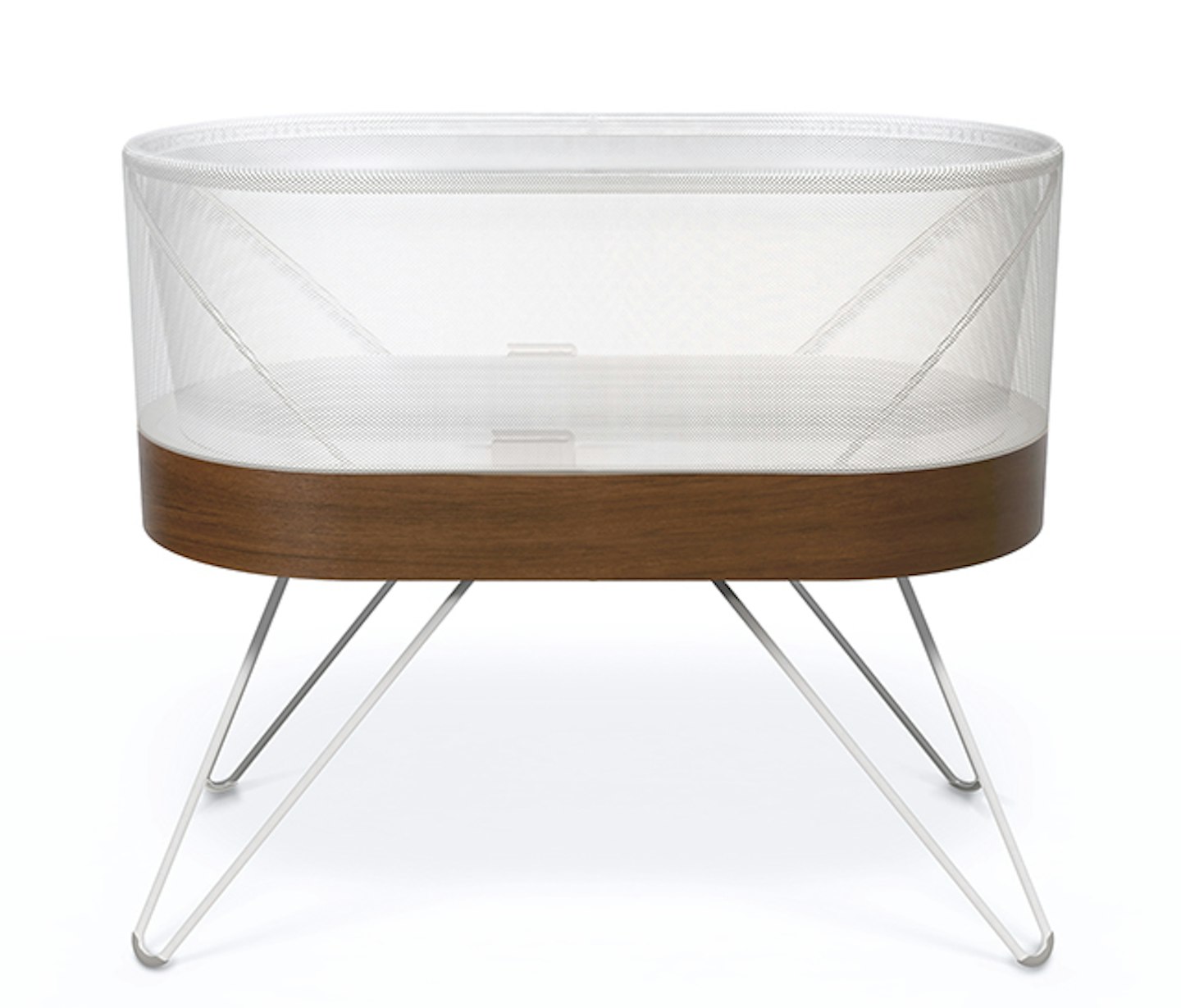
happiestbaby.co.uk
Pros
- Aids sleep
- Automatically responds to fussing
- Naturally sleep trains
Cons
- Requires power
- Only comes in one colour
| SNOO size in box: | 96.5 cm L x 55.9 cm W x 41.9 cm H |
| SNOO size when assembled: | 90.8 cm L × 48.3 cm W × 81.9 cm H (with legs); |
| Weight when assembled: | 17.4 kg |
| Suitable from: | Birth to 6 months (or when baby can get on hands and knees) |
- Special sleep sack makes swaddling easier, reduces overheating, prevents unraveled blankets and keeps baby on the back
- Soothes upsets with increasing motion + sound, often calming your baby in under a minute
- Breathable mesh walls for healthy air flow
- Advanced algorithm can recognise baby fussing from room noise
This combines a gentle rocking bed with soothing white noise and snug, safe swaddling, with 5 levels of specially designed sound and motion that imitate the calming sensations of the womb. You can pick which sounds and movements you want to use for your baby, with customisable settings that you control via an app on your phone.
This clever bed is also offered with a 30 day trial, so that you can make sure it's worth the investment. Scroll down to find out how Features & Reviews Editor Emily Gilbert got on when she tested out the SNOO Smart Sleeper. Emily used the bassinet right from birth until six months with her son Theodore.
Testing the SNOO Smart Sleeper
My first introduction to the SNOO Smart Sleeper was a couple of years ago when I saw an Instagram story from a sleep-deprived new mum enquiring 'If anyone was selling a SNOO.' It transpired that her daughter was simply not sleeping well and she was hoping the SNOO could help after seeing other success stories. While I never found out if she managed to get her hands on one, from then on, I was immediately intrigued by this so-called wonder crib.
So when I became pregnant myself, I jumped at the opportunity to review the SNOO. As a first-time mum, my experience of baby sleep is obviously pretty limited but the promises that the SNOO makes of aiding sleep are very appealing even if as a journalist, I am naturally a little sceptical.
Assembling the SNOO Smart Sleeper
The SNOO came in one big box and was incredibly well-packaged. There was no need to tear open the box (the idea is you keep the packaging), instead, you just unlock all four clips by pinching them in and pulling them out, ensuring to leave the tethers attached.
Shop this product
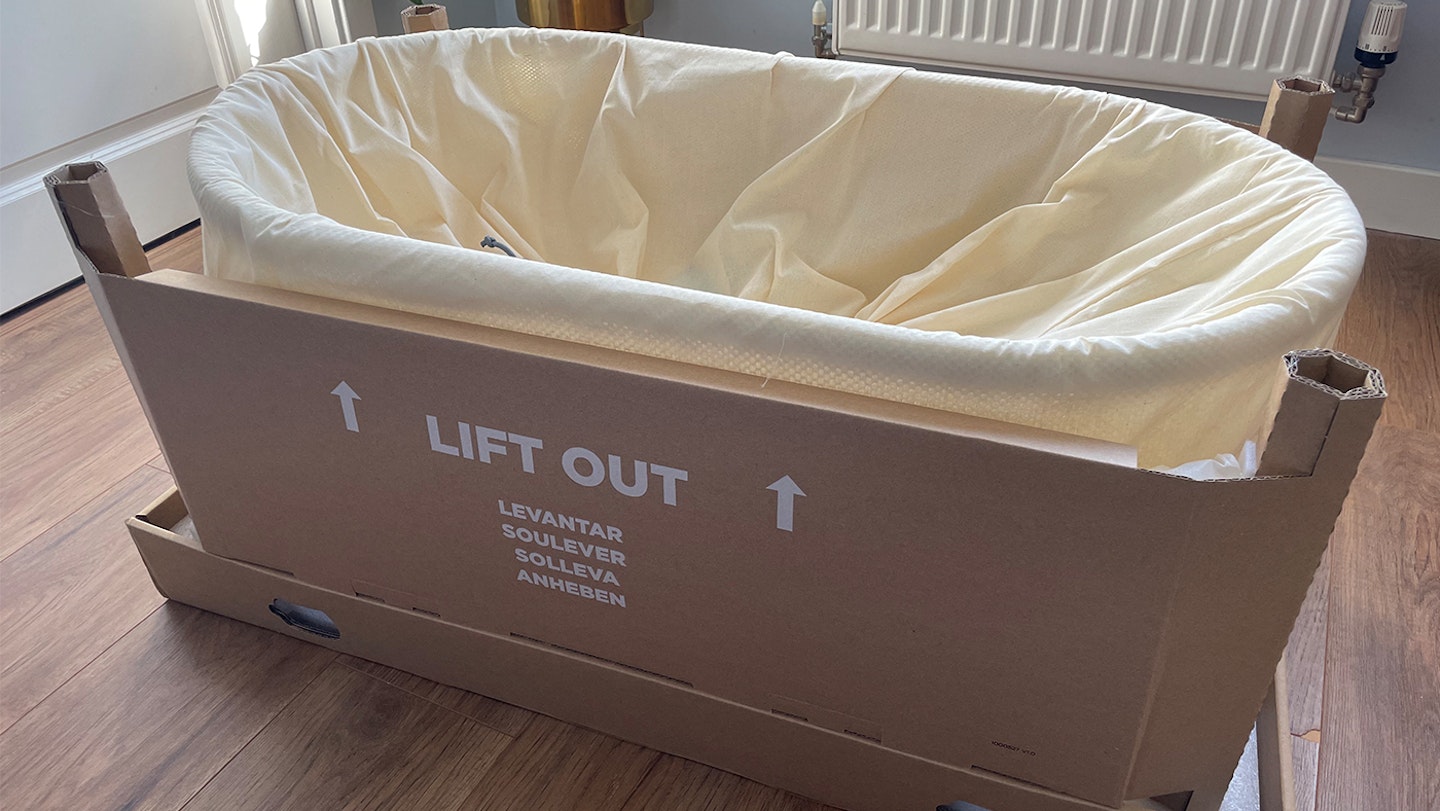
After lifting off the box lid and removing the pulp trays and support tubes, accessory box and SNOO legs, you are left with the cot itself which is handily housed in a dust bag. I found the addition of the dust bag really useful as it meant we could build the SNOO ready for our baby's arrival but keep it nice and clean in the meantime.
From there, it was simply a case of turning over the SNOO and attaching the legs. This consisted of just aligning the coloured arrows on the legs with the corresponding arrow on the bottom of the crib and pushing into the slot to secure it until we heard a click. We then turned the knobs until we felt resistance and repeated on all remaining legs.

After flipping the SNOO back over so it stood on its new legs, we plugged in the power cord and pressed this into the cord holder which we'd attached to the leg closest to our power outlet. And that was it! Just like that, the SNOO was assembled and ready for action.
The SNOO actually comes with instructions for how to fold down the packaging and boxes neatly so you can keep hold of these for when it's time to stop using the crib.
Aesthetics and design
There's no doubt that the Snoo Smart Sleeper is an attractive bedside crib. Both my husband and I marvelled at how nicely it fit in with the decor of our room with its clean and modern design. Putting it together, we could immediately see how high quality all the materials used to make it was.
While it does only come in one colour, I do feel like its stylish design means it would look at home in any bedroom, whatever your colour scheme.
Shop this product
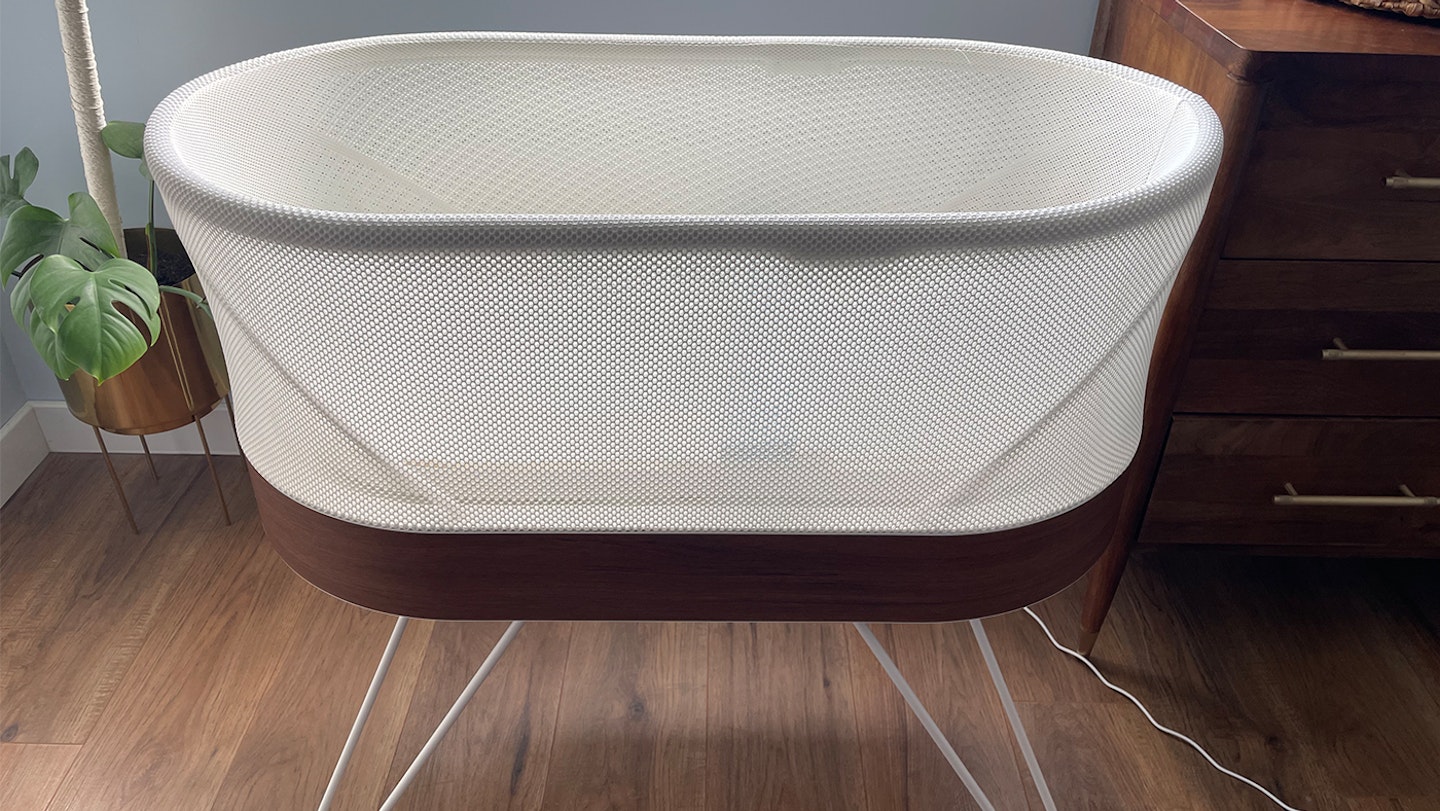
SNOO accessories
Finding out that you don't have everything you need to use the product within the initial cost can be very frustrating for any buyer but thankfully this isn't the problem with the SNOO - which you'd hope for with a product with such a high price point. In your box, you'll find:
• The SNOO Smart Sleeper
• 3 SNOO sacks in small, medium and large
• A SNOO sheet
• Mattress and water-resistant cover
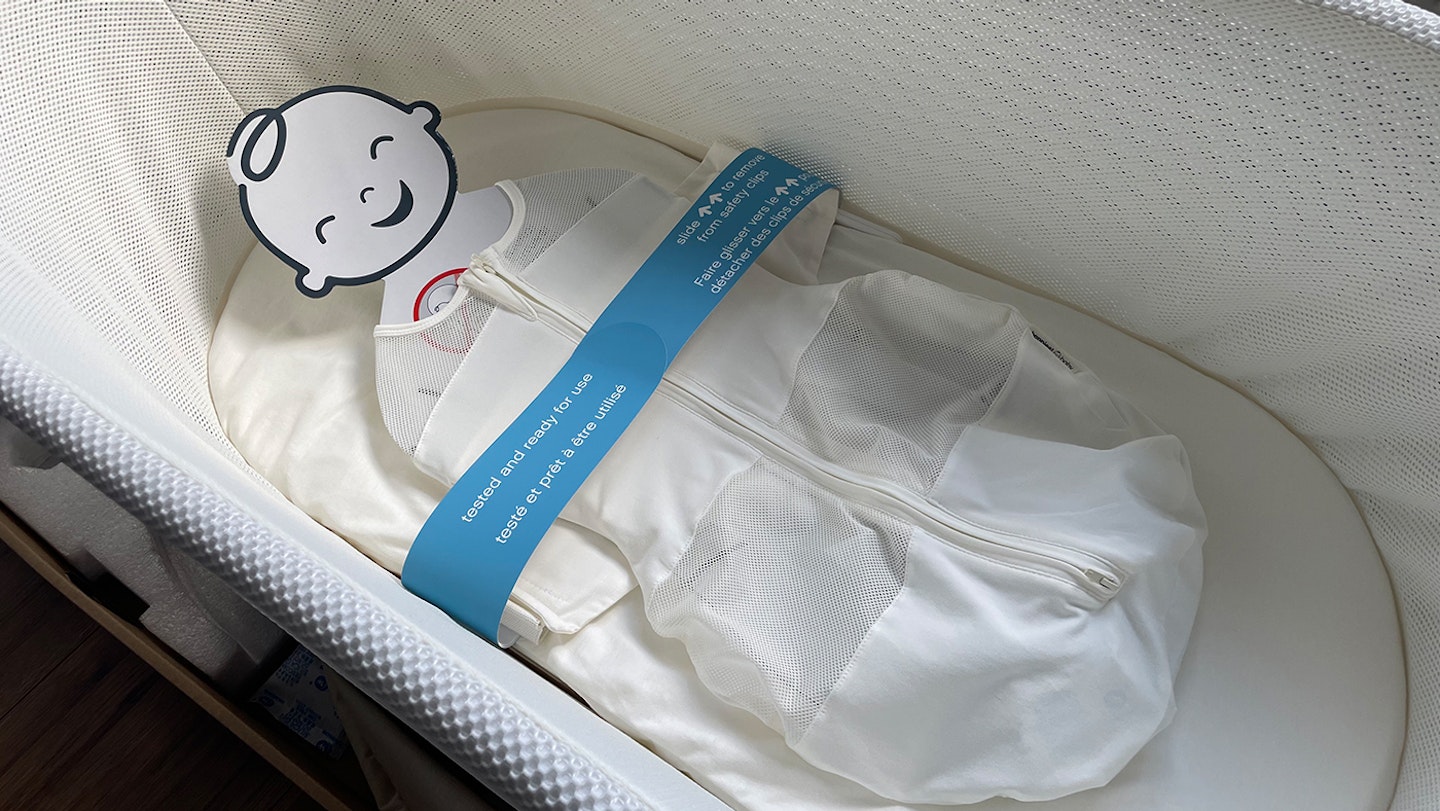
There are a number of other accessories that you may want to buy in addition such as more fitted cot sheets for laundry days or perhaps extra sleep sacks.
SNOO leg options
When considering the SNOO as our bedside crib, one concern I had was how easy it would be to actually see our baby from our bed. With traditional next-to-me cribs, there's usually a drop-down side so you can easily keep an eye on your little one and reach in to pick them up for a nurse or cuddle. Additionally you can usually adjust the height of the crib so that it's at a suitable level with your bed.
While SNOO does not have a drop-down side and nor can the legs it comes with be adjusted, there is the option to buy low legs if the SNOO sits too high for your liking. As you can see from the photos below, the SNOO was quite a bit higher than our bed and would require us to sit up to see inside.
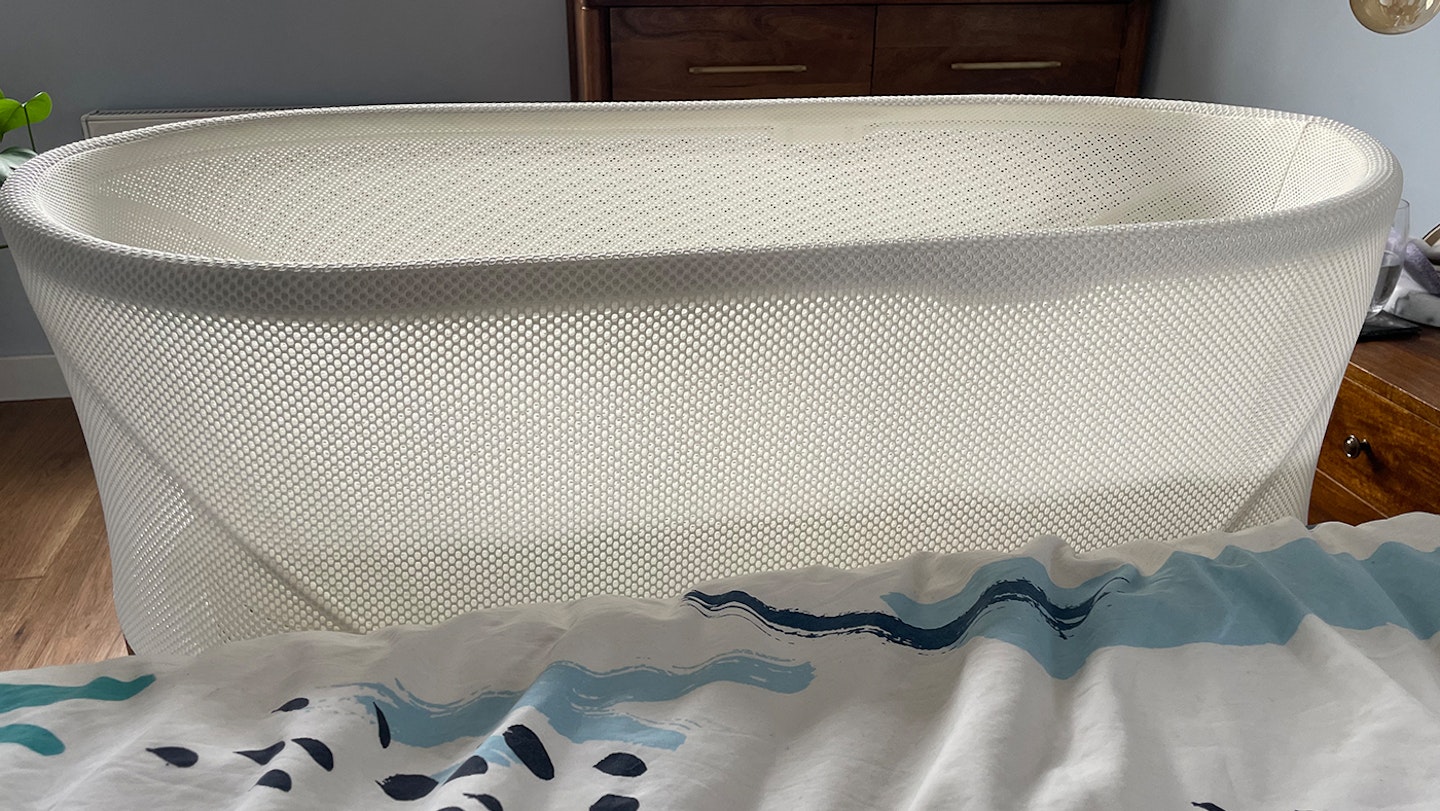
Shop this product
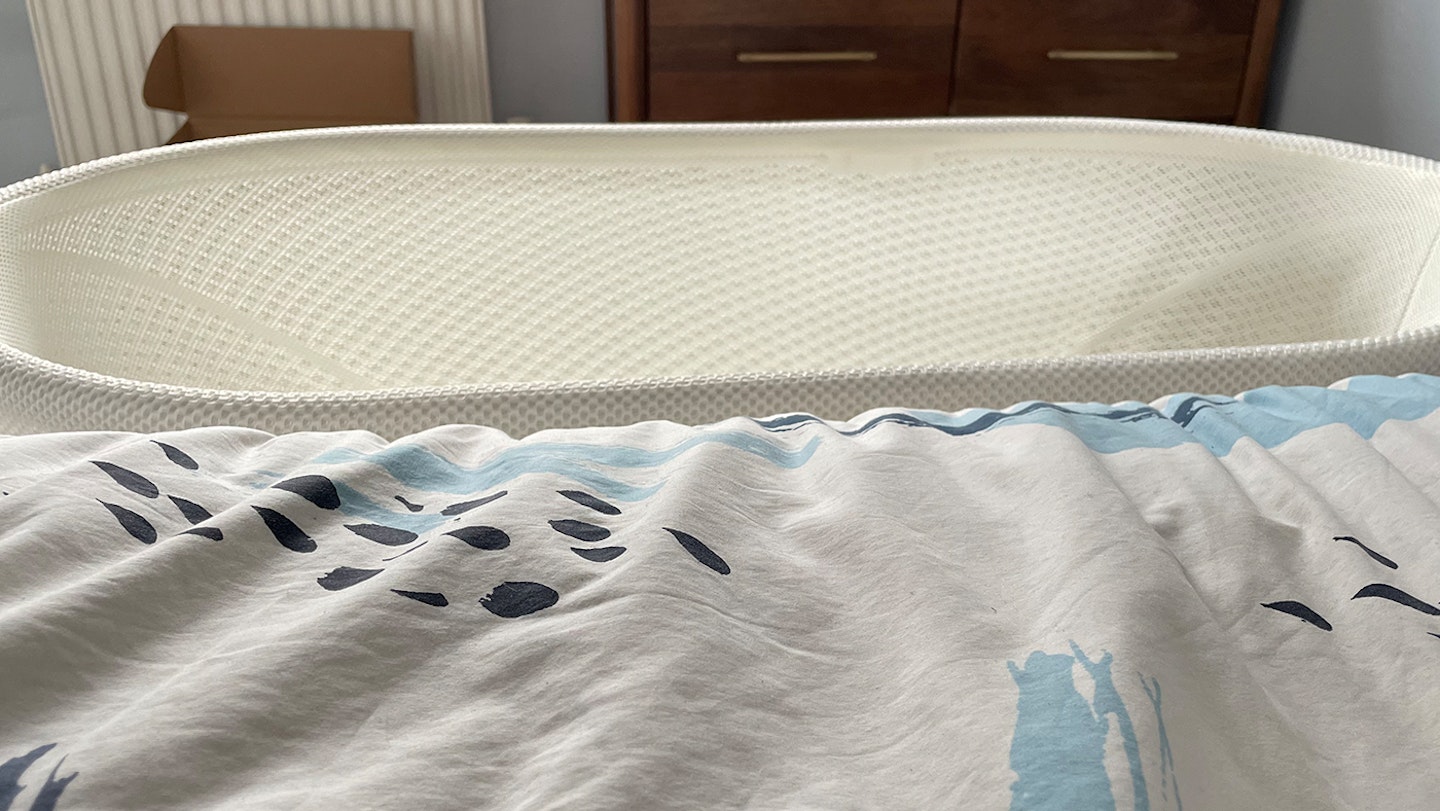
On the contrary, when we installed the low legs (as seen in the photo above), we found this gave us a much better angle to see inside the crib (and therefore to check on our baby in the future). While it isn't exactly much of a hardship to have to sit up to check on your baby, we personally much prefer having the SNOO lower.
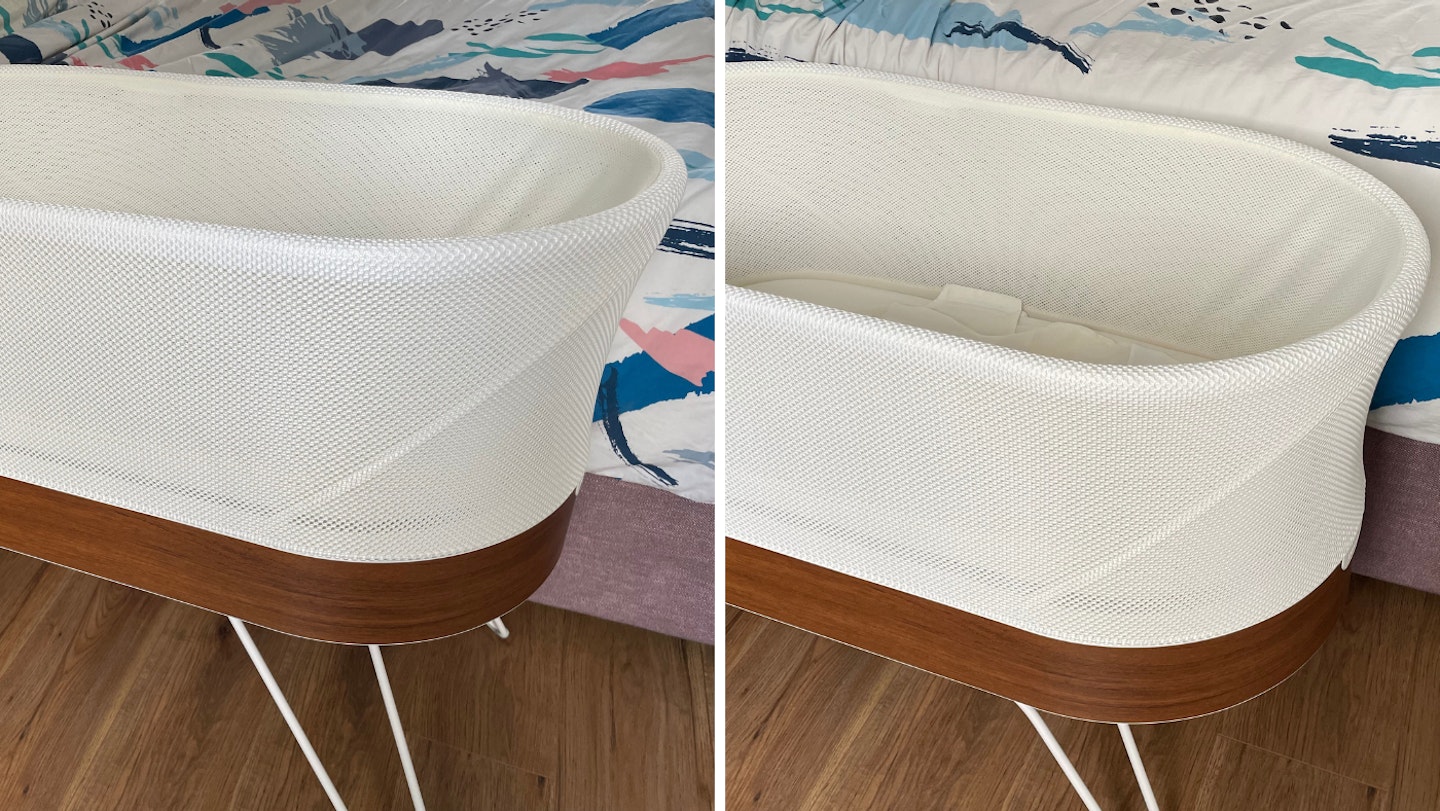
You can also buy a pair of two leg lifters for your SNOO which raises the head of the SNOO to a mild incline which is said to help with baby reflux and mild colds.
How to use the SNOO Smart Sleeper
I was relieved to find that actually using the SNOO is very straightforward. After all, what tired parent wants to make their lives even more complicated?
First off, you need to swaddle your baby in the SNOO Sleep Sack. This involves opening it up and laying baby down, making sure their shoulders are 2-3” higher than the neckline of the sack before straightening both arms and pulling across the inner arm bands across their chest. You then secure the leg flap and pull the top of the Sleep Sack over both shoulders before fully zipping up the sack.
Next, it's time for putting baby into the bassinet itself. Ensuring their feet are at the end nearest to the power button, you simply slide the loops on each side of the Sleep Sack onto the safety clips on each side of the crib. These must be used whenever baby is in the SNOO (whether the power is on or not) and are what help to keep baby in place on their back and prevent them from rolling over.
You then locate the power button on the SNOO and press it once. It takes about a minute before the button stops blinking white and you need to press it again, when the button will then turn blue and the SNOO turns on. I found it really reassuring that the SNOO won't turn on if the wing loops are not secured properly.
When it starts, the SNOO begins at the baseline level of motion (a gentle rocking) with accompanying white noise. The idea is that when your baby fusses, SNOO will give them a few seconds to self-soothe but if the crying continues, it rocks slightly faster and increases the volume of the white noise, cycling through four levels of increased sound and motion, aiming to send them back off to sleep. If baby stops crying - great! But if not, after a couple of minutes, the smart sleeper will stop and that's when you know your little one needs a change, feed or good old-fashioned cuddle.
You can manually increase the SNOO's level of sound and motion by pushing in the activity button for a few seconds, where it will advance to the next level. This can be continued to reach the fourth and final level.
The SNOO's levels can also be controlled via the smartphone app, whether you want to increase or reduce it.
To turn off the SNOO, just press the activity button once.
Shop this product
Using the Snoo 0-8 weeks
We started using the SNOO with our son on the first night we got home from the hospital when he was three days old. We had endured three sleepless nights in the hospital consisting of cluster feeding, constant round the clock monitoring and the crying of both our baby and the others on our ward. To say we desperately needed a good nights sleep was an understatement, but then what new parents don’t?
Strapping Theodore into the SNOO was much easier than I’d anticipated. Yes, the SNOO sacks look like little straight jackets and the first couple of times using it admittedly made me feel a bit weird but I can completely see why it’s so comforting to babies, reminding them of being tucked up cosily in the womb.
Immediately after firing up the SNOO for the very first time, Theodore let out a big yawn. We backed slowly away from the cot, watching as his eyelids began to flutter close. We were impressed, but still a little sceptical as we climbed into our own bed, both wondering how long it would be until we were woken by our newborn. It turns out that when our son did decide to wake up, mewing for his next feed, it was five and a half hours later. Both my husband and I were shocked but reasoned that this amount of sleep surely couldn’t be the norm for a baby so young, he was probably still recovering from being born, right?
But no, the next night Theodore slept for five hours and 15 minutes before feeding and going back into the SNOO for a further 2 hours. The third night, he slept for a whopping 6 hours and 22 minutes. And each night, the trend continued. From his first night in the SNOO, our newborn son would sleep each night anywhere between 5 and a half hours and even up to seven hours in one stretch. We couldn’t believe our luck. And frankly, we still can’t.
It’s worth noting that it is recommended that young babies are woken every three hours for a feed so we kept a close eye on Theodore’s weight, ensuring he was weighed regularly so we could keep a close eye on how he was progressing. But every single appointment found his weight to be spot on where it should be for his age so we felt comfortable continuing letting him sleep through.
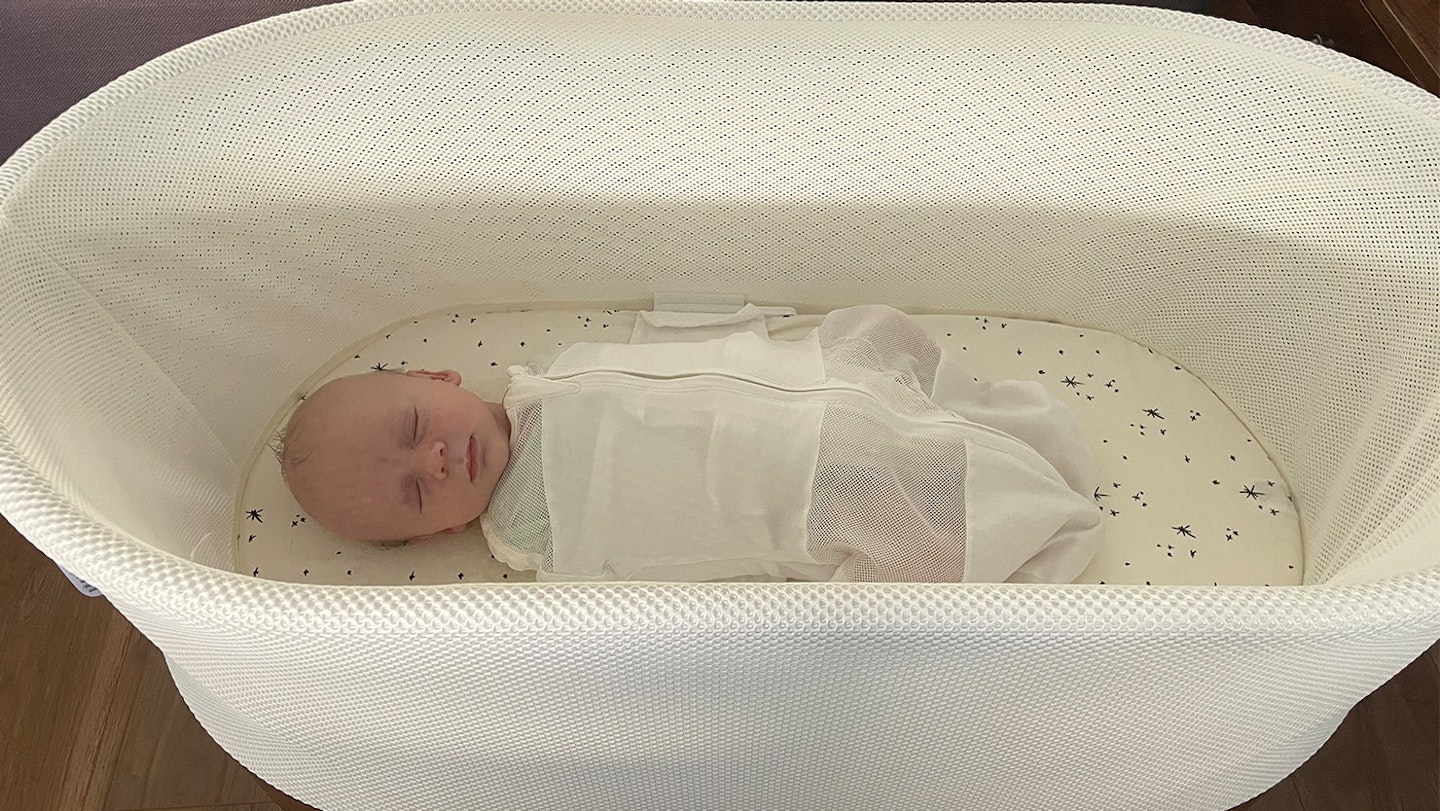
Shop this product
While Happiest Baby advises that the SNOO is used for all naps as well as at night time, the NHS recommends that babies under six months are kept in the same room as you at all times so for eight weeks, we primarily used the SNOO just at bedtime. It wasn’t until very recently that we felt comfortable letting Theodore take the odd nap in the SNOO if we were upstairs in very close vicinity. This resulted in naps that lasted much longer than the daytime naps usually taken in our normal bedside crib that lived in our living room.
Like any new parents, for the first few days we found ourselves constantly checking our son was breathing but soon, the fact that there were no loose blankets and that the SNOO kept him flat on his back really helped ease any nerves and we were able to relax.
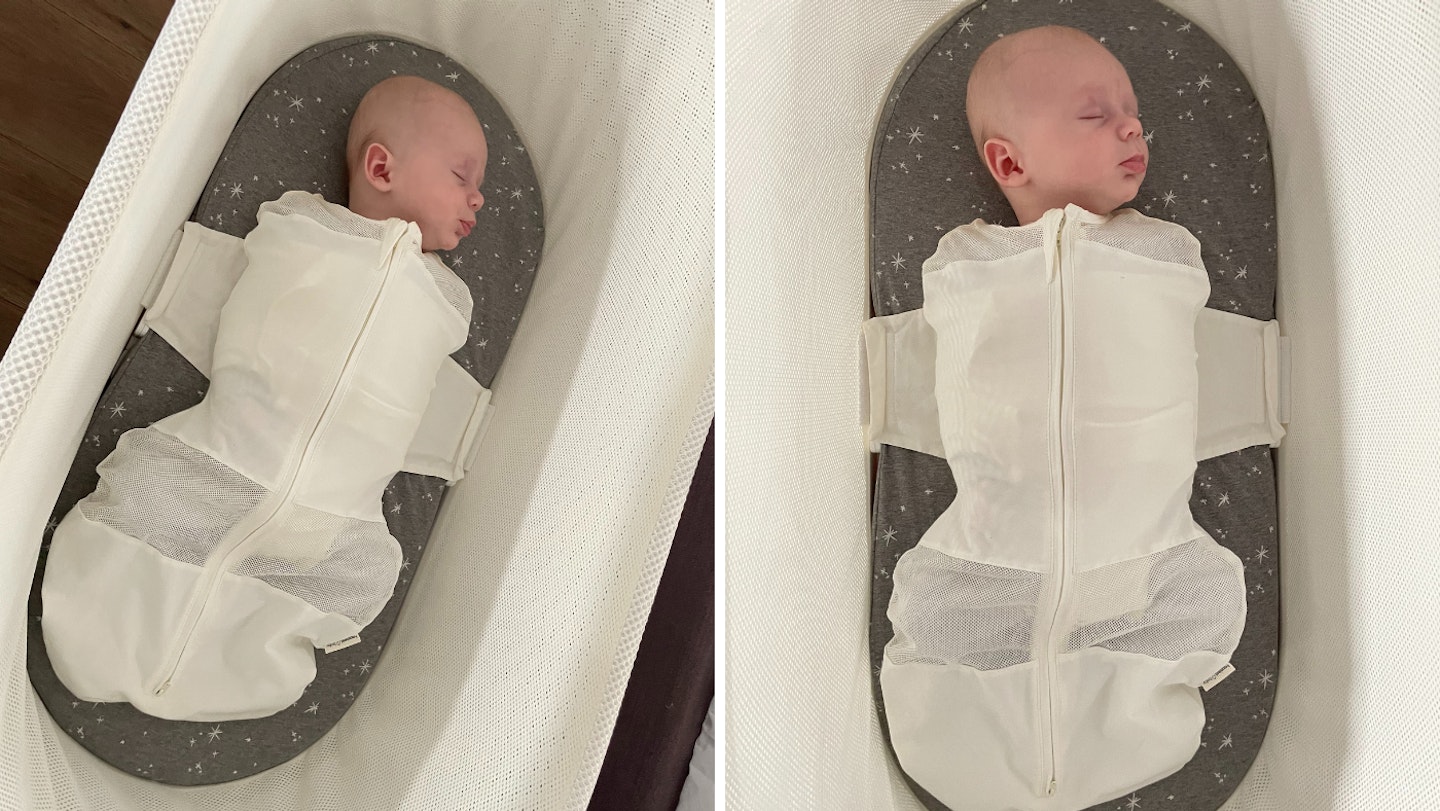
The SNOO is magic but it also…isn’t. If your baby isn’t tired, the SNOO isn’t going to force them to be. We’ve had a couple of times where we attempted to put our child in the SNOO and he simply wasn’t having it because he wasn’t ready for bed. This was one of my favourite features of the cot, knowing that we would very quickly know if the SNOO was going to work and that it wasn’t going to try for longer than two minutes to soothe him. Equally, if your baby is hungry, obviously nothing in the world is going to convince them that they’re not - as it should be.
In the case of our baby, the SNOO rarely reached Level 1 as the baseline was enough. Because our baby was having such long stretches of sleep, when our baby started fussing after his nighttime sleep, we knew he’d be hungry and tended to intercept the SNOO before it started levelling up so that we could feed him.

We didn’t use the accompanying app straight away as we had enough to get to grips with as first time parents but when we did, it was helpful to find that within the settings we could tweak everything from the volume to the motion start level to the responsiveness (very low, low, normal, high and very high) and the duration of the sleepytime sounds, aka the white noise. Speaking of which, neither me nor my husband found the SNOO interrupted our own sleep whatsoever; in fact my husband actually found the sleepytime sounds very relaxing.
Shop this product
For those using the SNOO for daytime naps, the app also lets you know when the cot has increased a level and is soothing baby and when they need your attention. It also creates a log of the sleep they have and you can add everything from nursing to nappies, bottles and solids too.

Although at this point we had four months until Theodore moved to his own room, I couldn’t help but already feel a little nervous about how he would cope without the SNOO. Thankfully Happiest Baby has thought of this with the SNOO’s weaning mode, which you'll find out more about later.
Using the Snoo: 2-5 months
Thankfully, our positive experience with the SNOO continued way beyond the newborn days. We actually bought the cot along with us to Wales while on a family holiday, just to keep things consistent. This obviously wasn’t possible when travelling abroad to Portugal but we followed the advice from Happiest Baby and replicated the SNOO experience as much as possible by packing a Sleepea Swaddle (the same of which is in the SNOO cot albeit without ‘wings’) and SNOO bear, a responsive teddy bear which plays the same white noise as the SNOO. Even without the movement, our son continued to sleep well in the hotel’s travel cot, which was a relief considering we knew eventually he would have to be weaned from the SNOO.
Our son started to roll just before his turned four months old. Typically, this is when babies would stop being swaddled with their arms inside to prevent the risk of being of sleeping on their front (and therefore the risk of SIDS). However, because the SNOO swaddle is built in and attached to the crib itself, there’s no risk of this happening as baby’s remain on their back and we could continue to swaddle our son in the SNOO.

Shop this product
Unlike many of our parent friends, we definitely had an easier ride when it came to the 4-month sleep regression, something that I do believe was helped massively by the SNOO cot. By this point, our son was sleeping from 8.30pm-6am and when the regression hit, we had a few nights where our son woke up a couple of times during the night. Quickly, the SNOO would kick into action, and he was back to sleep within moments - meaning we were too. During this period, our son would sometimes fight naps and become overtired as a result and the SNOO was a godsend in helping soothe him to sleep when he was being fussy.
Whether it was the effect of the SNOO or not I don’t know but our ‘experience’ of the 4-month sleep regression was certainly much tamer than the horror stories we’d been told by others and Theodore’s sleep settled back down to how it had been within a matter of days.
Using the Snoo: 5-6 months
Although my son is quite long for his age, I wasn’t worried about him not fitting in the SNOO because like most babies, he sleeps with his hips and legs open in a frog-like position, rather than straight, so his feet never touch the end of the crib. It has also been made to fit a baby up to 33 pounds.
It was actually when we noticed that we seemed to be disturbing Theodore when we were in the room that we started considering the process of transitioning him to his cot in his nursery.
Step one:
Following The Happiest Baby’s advice, we started with step one, freeing the arms. While THB recommends undoing the snaps at the shoulders of the SNOO sack of just one side to start with, we actually went straight in with him having both arms out at once. Admittedly, it didn’t quite go to plan.
Our son has a consistent bedtime every night and usually goes down without fail but on this night, he just wouldn’t settle and SNOO went right to Level 4 trying to soothe him before stopping. We waited a couple of minutes and interestingly, when my husband went to check on Theodore, he was asleep. We deduced that having his arms bouncing around with the movement of the SNOO rather than secured to his body as usual had been what had been upsetting him but when the SNOO had stopped and he was still, he was much happier. We turned the SNOO back on, he remained asleep and since that night, we haven't have any problems with Theodore sleeping with his arms out.

Step two:
The next step was turning on the Weaning Feature, which we did after a week of arms out. This is a premium feature that is only included with SNOO when you buy directly from Happiest Baby or an authorised partner which in the UK, is Harrods.
I toggled the Weaning Feature on via the app. This would turn off the motion of the SNOO but the soothing white noise would continue. The motion would come back on if and when baby starts to fuss, gradually stopping again when baby was content.
On the first night of trying the Weaning Feature, our son seemed to miss the absence of movement and fussed a little, leading the movement to kick back in. He then fell asleep but when the movement stopped, he didn’t wake up. For his next few naps, he fell asleep during his feeds, but when transferred into the SNOO, didn’t wake up. And when he was put down for naps and at bedtime while still awake, the white noise was still enough to help send him to sleep. We actually ended up turning down the sensitivity of the SNOO’s responsiveness around this time as we found the motion would kick in when he would wake and was laying chatting to himself, which we didn’t want.
Step three:
The third and final step was moving Theodore to his own room. He'd had a few successful naps during the day in his cotbed but not an overnight sleep. We continued to follow THB's advice, which included using the Sleepea swaddle with his arms out (essentially the SNOO Sack without the wings) and playing white noise from the SNOObear, which emits the very same sounds from the SNOO. I really think the familiarity of both the swaddle and the white noise helped my son feel comfortable as he continued to sleep well without any disturbance, even in his own room and out of the SNOO bassinet.
Final verdict
To this day, I still can’t believe how successful our experience with the SNOO has been. At the time of writing this, my son is 10 months old and still sleeps incredibly well.
In the early months, there was not a single night since returning home from the hospital that we didn't get a minimum of five and a half hours of sleep and typically after a feed, our son would then go back down in the SNOO for another couple of hours before we started our day, meaning we enjoyed just under eight hours of sleep most nights, if not more, something that feels unheard of with a young baby.
Both my husband and I couldn't help but feel guilty as we listened to friends with their babies talk about the sleep deprivation they suffered. I can only imagine how tough it is to parent a baby when you’re surviving on very little sleep although, naturally, I'm incredibly grateful that we haven't personally been in that position. To this day, Theodore is still a brilliant sleeper and goes down at night without fail for a 12-hour stint.
It goes without saying that the SNOO is a very expensive product, especially when you consider that you’ll only use it for six months. Affording one understandably isn’t possible for every family. I would love to see Happiest Baby introduce a rental system like they do in the US, to make the cost more affordable and so that many more families can take advantage of the SNOO’s wizardry.
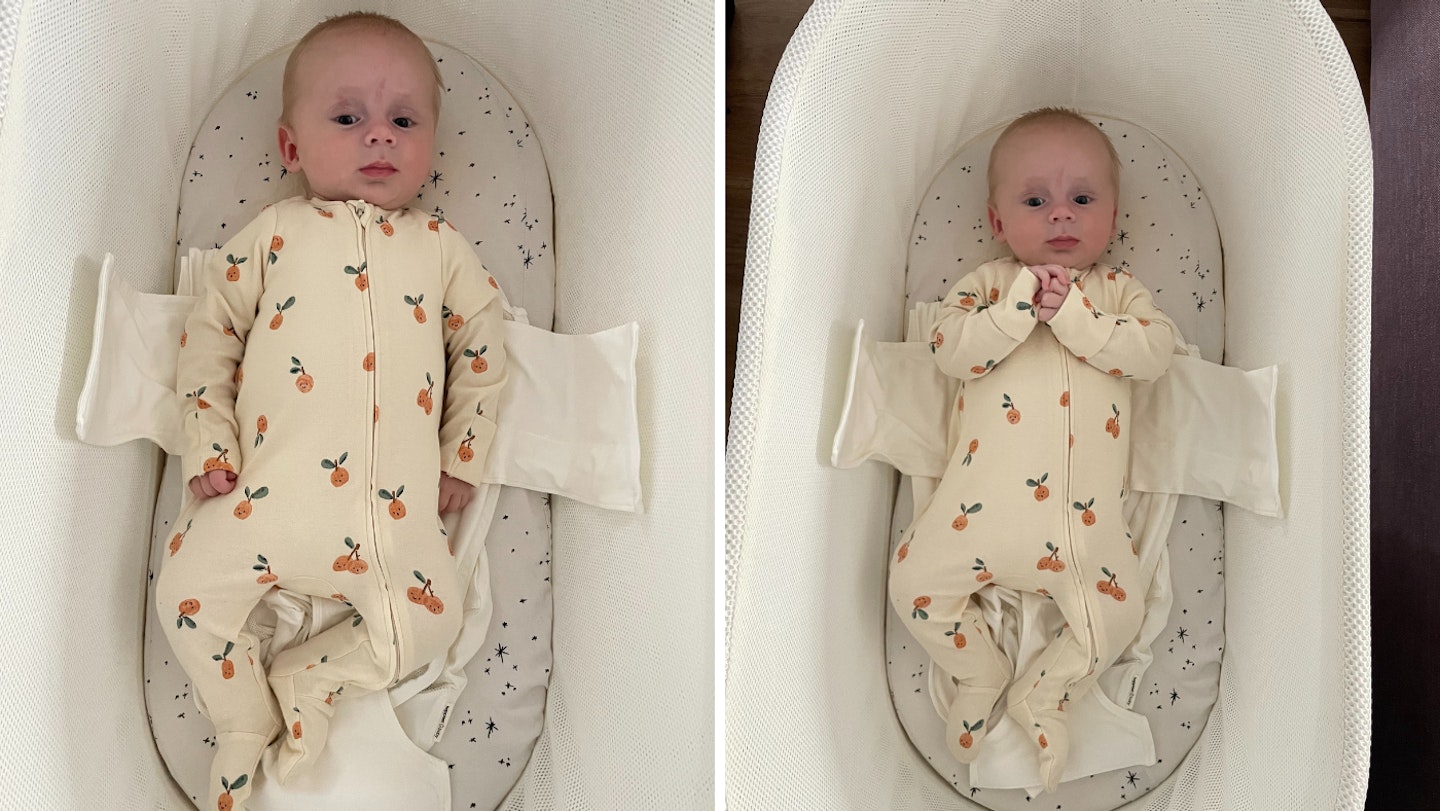
SNOO Smart Sleeper FAQs
Is a SNOO really worth it?
The SNOO Smart Sleeper rocks your baby and plays white noise to help them to fall and stay asleep, which recreates the experience of being in the womb. As a result, babies should sleep better and most new parents will agree that makes it worth it. The SNOO also responds to babies and will speed up the motion and increase the sounds if baby is unsettled, which helps them to relax. Being a new parent is hard enough, and even harder when sleep deprived, but the SNOO will help parents and baby sleep better. There is also an app which lets you customise settings and track your baby's sleep. This will help develop sleeping patterns for your baby.
Do babies become dependent on SNOO?
Your baby will enjoy the motion of the SNOO and find it comforting, but they will not get addicted to it. In fact, the SNOO actually has a weaning feature which will help you transition your baby to a cot. It is designed to be used up to six months, so it is there to support you and baby during those early days and you shouldn't worry it will cause any problems beyond that.
Can you use the SNOO without WIFI and does it use a lot of electricity?
Yes, you can use the SNOO when not connected to the WIFI but you will lose some features. If not connected, you will be unable to use the remote function of the SNOO. It is also energy efficient and will not use a lot of electricity even when on all night, or even day! It has the same wattage as a standard lightbulb.
Should you only use SNOO at night?
You can start using the SNOO from the day you bring baby home and you can use it for naps and during the night. The sooner baby goes into the SNOO the quicker they will start to get used to the cues it provides that it is time to go to sleep. Your little one will enjoy the soothing rhythm any time of the day or night, plus it should help them to start to differentiate between day and night and support them in self-settling. Of course, you must always follow safe sleep practices as set out by the NHS and The Lullaby Trust.
Emily Gilbert is a first-time mum to Theodore and the Features & Reviews Editor for Mother&Baby. She has written for the website and previously the magazine for seven years. Specialising in product reviews, Emily is the first to know about all the exciting new releases in the parenting industry.
